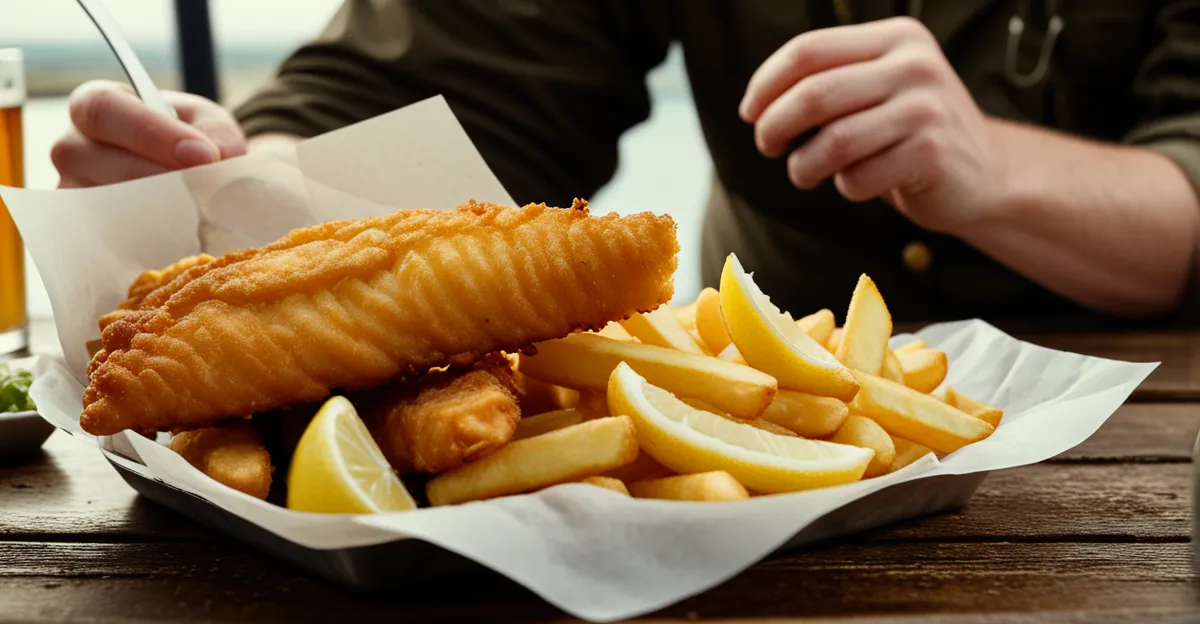Essential Ingredients for Perfect Fish and Chips
To recreate traditional British fish and chips, selecting the right fish and chips ingredients is crucial for authentic flavour and texture. The best fish for fish and chips often comes down to white fish with a mild flavour and firm flesh. Cod and haddock are the most popular choices, prized for their flaky texture that holds up well to frying. Pollock or plaice can be alternatives, but cod remains the gold standard in many classic recipes.
When it comes to the potato varieties used for chips, starchy potatoes like Maris Piper or King Edward are preferred. These potatoes provide the ideal balance between fluffiness inside and crispiness outside when fried. Avoid waxy potatoes, which tend to become soggy.
This might interest you : What Unique Flavors Define Traditional British Cooking?
The combination of these quality fish and potato choices allows home cooks to approximate the texture and taste of the iconic British takeaway. Paying attention to ingredient selection elevates the dish beyond just frying fish and cutting potatoes—it’s about achieving the crispy, golden finish and tender interior that defines this British staple. Using the right fish and chips ingredients ensures your homemade batch captures the spirit of traditional British fish and chips precisely.
Essential Ingredients for Perfect Fish and Chips
To create authentic fish and chips that reflect traditional British standards, selecting the right ingredients is crucial. The best fish for fish and chips is typically white, flaky, and mild. Cod and haddock are classic choices favored for their delicate texture and subtle flavor. Haddock tends to have a slightly sweeter taste, while cod offers a firm, meaty bite. Both absorb batter beautifully, ensuring a crispy, golden exterior.
In the same genre : How Can British Cooks Innovate Traditional Recipes Without Losing Their Essence?
When it comes to fish and chips ingredients, freshness is paramount. Fresh, skinless fillets yield superior results compared to frozen options, which may release excess water, causing soggy batter.
Equally important are the potato varieties used to make chips. Traditional British fish and chips often feature thick-cut chips made from starchy varieties like Maris Piper or King Edward. These potatoes have the right balance of starch and moisture to produce crispy exteriors with fluffy interiors after frying.
In summary, perfect fish and chips demand careful attention to ingredient selection: fresh cod or haddock paired with starchy potatoes ensure the classic taste and texture that define this beloved dish.
Preparing Fish and Potatoes the British Way
Mastering fish preparation techniques is essential for traditional British fish and chips. Start with filleting the fish carefully to remove bones and excess skin, ensuring a clean, even fillet that fries uniformly. Proper filleting prevents uneven cooking and helps the batter adhere better to the fish.
When it comes to potato cutting, thick, chunky cuts are characteristic of British chips. Slice starchy potatoes like Maris Piper or King Edward into thick batons roughly 1¼ to 1½ inches wide. This thickness allows the potato to develop a fluffy interior while the exterior crisps nicely during frying.
Pre-soaking the cut potatoes in cold water is a vital step to remove excess surface starch. Soak for at least 30 minutes, then dry thoroughly with a clean kitchen towel. This reduces the chance of soggy chips by ensuring oil interacts directly with the potato surface.
For the fish, patting the fillets dry before battering is crucial; excess moisture causes the batter to slide off and compromises crispiness. Proper drying also helps achieve an even, golden crust during frying. Paying attention to these preparation details replicates the authentic texture and flavour expected from traditional British fish and chips.
Secrets to a Crispy Batter and Golden Chips
Achieving a crispy batter is fundamental to traditional British fish and chips. The batter ingredients typically include plain flour, cold sparkling water or beer, and a pinch of baking powder to add lightness. Cold liquid helps the batter stay crisp after frying. Mixing gently until just combined prevents gluten overdevelopment, which can toughen the coating. Overmixing is a common mistake that affects crispiness.
Consistency matters: the batter should be thick enough to cling to the fish but still runny enough to coat smoothly. Testing the batter by dipping a spoon and observing how it flows can help gauge the ideal texture.
Double frying chips is an essential technique for golden, crunchy results. First, fry the chips at a lower temperature (around 140°C/285°F) until tender but pale. Remove and drain. Then, increase the oil temperature (to about 180°C/350°F) and fry the chips again to crisp and brown them. This two-step process locks in moisture while creating a perfectly crisp exterior.
Similarly, fish is dipped just before frying to maintain batter texture. Avoiding batter saturation and cooking at the right temperature preserves the signature crunch and golden colour central to traditional British fish and chips.
Secrets to a Crispy Batter and Golden Chips
Achieving a crispy batter is essential to authentic traditional British fish and chips. The key lies in the batter ingredients, combining plain flour, cold sparkling water or beer, and a pinch of baking powder to create a light, airy coating. Cold liquid keeps the batter crisp during frying because it prevents gluten from developing excessively, which can make the coating tough rather than crunchy.
Maintaining the right batter consistency—thick enough to coat the fish but not too heavy—is vital. The batter should smoothly drip off the fish, creating an even layer. Overmixing can cause the batter to lose its lightness, so mix gently until just combined.
Fish and chips batter tips often include resting the batter for at least 30 minutes before use to enhance texture. Also, keeping both the batter and fish cold before frying helps snap the coating crisp quickly in the hot oil.
For the chips, the double frying technique is indispensable. First fry the cut potatoes at a lower temperature to cook through, then drain and cool them. A second fry at higher heat crisps the exterior perfectly. This method ensures golden, crunchy chips with fluffy interiors—an unmistakable hallmark of fish and chips ingredients done right.
Frying Techniques for Authentic Texture
Achieving the ideal deep frying environment is crucial for perfect traditional British fish and chips. Selecting a suitable cooking oil with a high smoke point, such as vegetable or sunflower oil, prevents burning and off-flavours when frying at high temperatures. Maintaining the correct oil temperature for fish and chips—typically between 170°C and 180°C (340°F to 360°F)—ensures the batter crisps quickly, sealing in moisture without absorbing excess oil.
Using appropriate fish and chips equipment like a deep fryer or heavy-bottomed pan provides consistent heat distribution. Frequent temperature checks with a reliable thermometer help avoid overheating or cooling, which leads to soggy batter or greasy chips.
Batch frying is another essential technique to retain oil temperature and prevent the food from overcrowding, which causes uneven cooking and sogginess. Fry fish and chips in small batches, allowing oil temperature to recover between loads.
Additionally, draining fried items thoroughly on wire racks or paper towels reduces residual oil. These frying techniques work together to deliver the perfect crispy exterior and tender interior expected in authentic British fish and chips. Consistency in temperature and method elevates home frying to restaurant-quality results.
Avoiding Common Mistakes in Homemade Fish and Chips
A frequent fish and chips mistake is soggy batter, often caused by excess moisture on the fish or improper oil temperature. Ensuring the fish is thoroughly dried before battering is essential. Moisture on the fillet clogs the batter, preventing it from crisping correctly. Cooking at the right oil temperature for fish and chips—between 170°C and 180°C—is vital to avoid greasy, heavy batter.
Overcrowding the pan leads to oil temperature drop, producing uneven frying and greasy chips. Batch frying helps maintain consistent heat and crispiness. Another common error is overcooking, which dries out the fish and hardens the batter. Fish should be fried just until the batter turns golden and the flesh flakes easily.
Seasoning at the proper time also influences flavour; salting immediately after frying ensures the seasoning adheres without drawing moisture, which can cause sogginess. Avoiding these typical errors enhances the overall texture and taste, making your homemade fish and chips more enjoyable and authentic.
By understanding and troubleshooting common fish and chips mistakes, home cooks can elevate their results, achieving the crisp, tender qualities central to traditional British fish and chips.
Avoiding Common Mistakes in Homemade Fish and Chips
One of the most frequent common fish and chips mistakes is soggy batter. This often happens when the batter is too wet or the fish isn’t dried properly before coating. Excess moisture prevents the batter from crisping up, so always pat the fillets dry thoroughly. Another issue is frying at incorrect temperatures. Maintaining the oil temperature for fish and chips between 170°C and 180°C is critical. Too low causes greasy, soggy food; too high burns the batter before the fish cooks through.
Overcrowding the fryer leads to uneven cooking and temperature drops, a typical fish and chip error. Fry in batches to keep oil hot and ensure a crispy finish. Under or overcooking fish results in dry or raw interiors—timing and temperature control are essential here.
Seasoning is another overlooked area. Adding salt immediately after frying enhances flavour without making chips soggy. Some home cooks season before frying, which can draw moisture and cause sogginess.
By troubleshooting these issues, you can avoid the most common pitfalls in homemade fish and chips. Paying attention to fish drying, oil temperature, batch size, and seasoning timing transforms home cooking into authentic, crisp, traditional British fish and chips.
Essential Ingredients for Perfect Fish and Chips
Choosing the right fish and chips ingredients is fundamental to recreating traditional British fish and chips at home. The best fish for fish and chips is a mild, flaky white fish like cod or haddock. Cod offers a firm texture with a meaty bite, while haddock provides a slightly sweeter flavour. Both fish types excel in absorbing batter, which creates that crisp, golden coating characteristic of classic fish and chips.
Potatoes are equally important. The preferred potato varieties are starchy types such as Maris Piper or King Edward. These potatoes deliver the ideal combination of high starch and low moisture, resulting in chips that are crunchy on the outside and fluffy inside. Avoid waxy potatoes, as they can become soggy and lack the desired texture once fried.
Freshness matters, too—using fresh fish rather than frozen ensures a better texture and avoids excess moisture that can ruin the batter. Selecting quality ingredients tailored to traditional British preferences ensures your fish and chips match the authentic crispness and flavour expected from this beloved British dish.
Essential Ingredients for Perfect Fish and Chips
Choosing the right fish and chips ingredients is fundamental to crafting authentic traditional British fish and chips. The best fish for fish and chips revolves around mild-flavoured, white-fleshed fish with firm texture. Cod and haddock remain the premier choices, prized for their flaky yet substantial flesh that fries to a golden, crisp finish. Cod tends to offer a firmer bite, while haddock provides a slightly sweeter flavour, both absorbing batter well without becoming soggy.
Selecting appropriate potato varieties is equally crucial. Starchy potatoes like Maris Piper and King Edward are preferred because their high starch and low moisture content yield thick, fluffy chips with crispy exteriors. These potatoes withstand the double frying process better than waxy alternatives, which are prone to sogginess.
Freshness plays a vital role; using fresh fish instead of frozen prevents excess moisture, which can weaken the batter’s crispness. Combining premium fish and chips ingredients—fresh, firm fish fillets and starchy potato varieties—ensures that every bite captures the classic texture and flavour that define traditional British fish and chips.
Preparing Fish and Potatoes the British Way
Mastering fish preparation techniques is crucial for authentic traditional British fish and chips. Start by carefully filleting the fish, removing all bones and excess skin to ensure even frying. Proper fish filleting helps the batter cling better, resulting in a uniform, crispy coating that protects the flaky flesh inside.
For the chips, selecting the right potato varieties like Maris Piper or King Edward is fundamental. These starchy potatoes hold their shape well when cut. Slice them into thick batons, about 1¼ to 1½ inches wide, which is characteristic of classic British chips. This thickness ensures a fluffy interior and crispy exterior.
A key step in preparation is soaking the cut potatoes in cold water for at least 30 minutes. This removes surface starch, reducing the risk of sogginess during frying. After soaking, drying the potatoes thoroughly with a clean towel is essential to achieve the crisp finish expected from well-executed fish and chips ingredients.
Similarly, patting the fish dry before battering prevents excess moisture from causing the batter to slide off or become soggy. Attention to these preparation details elevates the texture and flavour, delivering the authentic taste of traditional British fish and chips.








